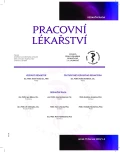Importance of screening electromyography within the framework of follow-up examinations in employees working at the risk of local muscular load
Authors:
T. Konvička
Authors‘ workplace:
EUC Premium s. r. o., odborný ředitel MUDr. Jiří Vytlačil
Published in:
Pracov. Lék., 71, 2019, No. 1-2, s. 13-16.
Category:
Original Papers
Overview
According to valid legislation, electromyography (EMG) is performed within the framework of occupational medical examinations as a part of entry and final examinations, respectively. The contribution deals with evaluation of the importance of regular performance of screening electromyography within the framework of follow-up examinations in employees working at the risk of local muscular load of category 3. Validity of the results of measuring the screening EMG was verified, in indicated cases, by neurological examinations by specialist outpatient departments.
The data were analyzed in a period of one year. The measurement employed made use the Alien TruTrace 4 device. The total of occupational medical examinations in the given year was 2444 and the number of examined workers was 2108. The EMG examination was indicated in 901 workers considering the risk at the workplace, while 153 of them suffered signs of lesions.
This communication does not evaluate statistical data, but a potential contribution of the screening examination within the framework of follow-up and possibly extraordinary examinations, where the screening was done in indicated cases.
Keywords:
distal motor latency – median nerve – screening electromyography – occupational medical examinations
Sources
1. SZÚ Nemoci z povolání v České republice, 2017. Dostupné na www: http://www.szu.cz/uploads/NZP/Hlaseni_NzP_2017.pdf.
2. Brhel, P., Říhová, A., Dufek, J. et al. Profesionální syndrom karpálního tunelu. Pracovní Lékařství, 1999, 51, 3, s. 123–129.
3. Dufek, J. Profesionální syndrom karpálního tunelu. Neurologie pro praxi, 2006, 7, 5, s. 254–256.
4. Mazanec, R., Nedělka, T., Bojar, M. Neuromuskulární poruchy u tyreopatie. Neurol. Praxi, 2012, 13, 1, s. 22–25.
5. Masopust, V., Beneš, V. Syndrom karpálního tunelu. Postgrad. Med., 2007, 9, 8, s. 841–843.
6. Smrčka, M., Vybíhal, V., Němec, M. Syndrom karpálního tunelu. Neurologie pro praxi, 2007, 8, 4, s. 243–246.
7. Šplíchalová, A., Pavuková, V., Vaňková, D., Tomášková, H. Korelace mezi symptomy a elektromyografickými nálezy u pracovníků v riziku vibrací a přetěžování horních končetin. Pracovní Lékařství, 2014, 66, 1, s. 25–32.
8. Solomon, D. H., Katz, J. N., Bohn, R., Mogun, H., Avorn, J. Nonoccupational risk factors for carpal tunnel syndrome. J Gen Intern Med., 1999, 14, 5, s. 310–314.
9. Nordstrom, D. L., Vierkant, R. A., DeStefano, F., Layde, P. M. Risk factors for carpal tunnel syndrome in a general population. Occup Environ Med., 1997, 54, 10, s. 734–740.
10. You, D., Smith, A. H., Rempel, D. Meta-analysis: association between wrist posture and carpal tunnel syndrome among workers. Saf Health Work, 2014, 5, 1, s. 27–31.
11. Kadaňka, Z., Dufek, J., Hromada, J. Syndrom karpálního tunelu – Standard elektrofyziologického vyšetření syndromu karpálního tunelu pro potřeby hlášení choroby z povolání. [cit. 2015-12-15]. Dostupné na www: www.czech-neuro.cz/content/uploads/2018/02/sy-karpalniho-tunelu.docx.
12. Kadaňka, Z. Syndrom karpálního tunelu. [cit. 2015-12-08]. Dostupné na www: <http://www.neuromuskularni-sekce.cz/res/file/archiv/ns2006/08_Karpalni-tunel-2006.pdf>.
13. Vyhláška č.79/2013 Sb., o pracovnělékařských službách, Sbírka zákonů, 2013.
14. Kolawole Wasiu Wahab, Emmanuel O. Sanya, Philip B. Adebayo, Musbaudeen O. Babalola, Hakeem G. Ibraheem Carpal Tunnel Syndrome and Other Entrapment Neuropathies. Oman Med J., 2017, 4, 32, 6, s. 449–454.
15. Calogero Alfonso, Stefano Jann, Roberto Massa, Aldo Torreggian Diagnosis, treatment and follow-up of the carpal tunnel syndrome: a review. Neurological Sciences, 2010, 31, s. 243–252.
Labels
Hygiene and epidemiology Hyperbaric medicine Occupational medicineArticle was published in
Occupational Medicine

2019 Issue 1-2
Most read in this issue
- Evaluation of the nurses’ mental workload
- Nursing job satisfaction – the comparative study
- Burnout as a determinant of job performance of nurses
- Evaluation of local muscular load among seamstress of car seat cover sewing industry Part 2: The use of the time frame and measurement of the number of movements to evaluation of local muscular load
